Welcome to the first installment of my “Year in Bedlam” end-of-the-year movie rankings. The format and attitude, you’ll find, are identical to that of my “Year in Horror” pieces from years past, but with a much greater range of subject matter. As in my previous year end round-ups, this one features only those films commercially released theatrically or via digital/PPV format in the United States—film festival screenings don’t count.
Movies I missed in 2016 include the horror/cult flicks THE WAILER and IN A VALLEY OF VIOLENCE, and also a number of Hollywood blockbusters, including CAPTAIN AMERICA: CIVIL WAR and SUICIDE SQUAD. Then there were those movies I did see but for various reasons (valid ones, I think!) chose not to include in the listings, such as THE MEDDLER, MAGGIE’S PLAN and FENCES.
The most oft-repeated word in these reviews, you’ll find, is overrated. Yes, I’ve stated this elsewhere but it bears repeating: 2016 contained more overpraised films than any other year in recent memory. To learn precisely which films I feel were overrated, and why, read on…
The Best:
1. HACKSAW RIDGE
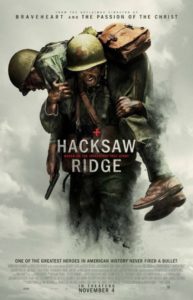 This film proves once again that Mel Gibson is a mighty talented filmmaker, even if he does have a tendency toward over-the-top sentimentality and religiosity. The fact-based HACKSAW RIDGE explores Gibson’s fascination with violence—in fact, it may well be his most violent-ever movie, although its attitude toward the carnage is far more complex and multi-faceted than those of BRAVEHEART and THE PASSION OF THE CHRIST. Andrew Garfield is quite strong as Desmond Doss, the first conscientious objector in US history to be awarded the Medal of Honor. The reason for that was his actions at the so-called Hacksaw Ridge during the Battle of Okinawa, which as depicted in this movie was an unrelenting bloodbath, the likes of which haven’t been depicted onscreen since the opening scenes of SAVING PRIVATE RYAN. As staged by Gibson the war scenes are suitably bloody and relentless—with pinpoint camerawork, editing and sound design enhancing the horror—yet grow increasingly ethereal and elegiac. That, however, only covers the film’s final 45 or so minutes, with the first portion depicting Doss’s small town upbringing, which is determinedly old fashioned in tone, look and visual design; these scenes are dominated by Hugo Weaving as Doss’s alcoholic father and the incandescent Teresa Palmer as Doss’s fiancée. Then there’s the middle section, dramatizing Doss’s rocky attempts at convincing his army superiors and fellow grunts of his pacifist convictions. A surprisingly strong Vince Vaughn plays the commanding sergeant in this section, a character arc that is paid off in the climactic battle scenes. A grueling, exhausting and ultimately transcendent experience.
This film proves once again that Mel Gibson is a mighty talented filmmaker, even if he does have a tendency toward over-the-top sentimentality and religiosity. The fact-based HACKSAW RIDGE explores Gibson’s fascination with violence—in fact, it may well be his most violent-ever movie, although its attitude toward the carnage is far more complex and multi-faceted than those of BRAVEHEART and THE PASSION OF THE CHRIST. Andrew Garfield is quite strong as Desmond Doss, the first conscientious objector in US history to be awarded the Medal of Honor. The reason for that was his actions at the so-called Hacksaw Ridge during the Battle of Okinawa, which as depicted in this movie was an unrelenting bloodbath, the likes of which haven’t been depicted onscreen since the opening scenes of SAVING PRIVATE RYAN. As staged by Gibson the war scenes are suitably bloody and relentless—with pinpoint camerawork, editing and sound design enhancing the horror—yet grow increasingly ethereal and elegiac. That, however, only covers the film’s final 45 or so minutes, with the first portion depicting Doss’s small town upbringing, which is determinedly old fashioned in tone, look and visual design; these scenes are dominated by Hugo Weaving as Doss’s alcoholic father and the incandescent Teresa Palmer as Doss’s fiancée. Then there’s the middle section, dramatizing Doss’s rocky attempts at convincing his army superiors and fellow grunts of his pacifist convictions. A surprisingly strong Vince Vaughn plays the commanding sergeant in this section, a character arc that is paid off in the climactic battle scenes. A grueling, exhausting and ultimately transcendent experience.
2. JACKIE
Surprisingly enough, this film, an unabashedly arty take on a subject in which I have little-to-no interest, turned out for me to be (after HACKSAW RIDGE) the most resonant of the end-of-the-year prestige pictures. It stars Natalie Portman as Jaqueline Onassis Kennedy, and dramatizes what occurred in the days following JFK’s murder, when a grief-stricken Jackie was unceremoniously booted out of the White House yet still worked to secure her husband’s legacy. One could certainly argue that the impossibly poised and well-spoken Jackie O. on display in this film doesn’t entirely mesh with reality (Jackie’s party girl ways are touched upon but never explored), but what makes JACKIE memorable is the wildly unorthodox treatment by director Pablo Larrain. He’s created a haunting and atmospheric reverie that freely juxtaposes differing time periods in a dreamy manner meant to represent Jackie’s unsettled state of mind, with a suitably eccentric score by Mica Levi (of UNDER THE SKIN) and gorgeously evocative cinematography by Stephane Fontaine. Then there’s the imposing work by Ms. Portman, who proves, not for the first time, that she can carry a movie with seemingly effortless grace.
3. HARDCORE HENRY
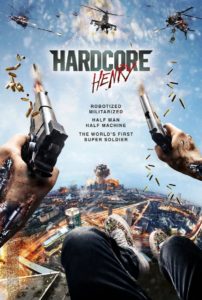 This demented masterwork received shockingly scant attention when it was released in early ‘16. Perhaps that’s for the best, as HARDCORE HENRY might very well have caused an outcry had more people seen it. It’s the most violent movie of the year, and also the most gleefully outrageous, effectively aping the look and feel of those first person shooter PC games. The subject is Henry, a dead man resurrected as a superhuman cyborg in an odyssey that comes to involve a lot of excess running, fighting and shooting. The gimmick is that the entire film is seen from Henry’s POV as he performs innumerable breakneck stunts and commits just as many acts of violence (such as ripping open an opponent’s chest and yanking out his heart), and the wonder is that writer-director Ilya Naishuller manages to sustain viewer interest throughout his unfailingly inventive 97 minute runtime (although the fisheye lenses and jump-cuts grow a bit wearying). Of course the film is never particularly resonant, existing on the level of the PC games it recalls, but as a kinetic spectacle it’s nearly without precedent.
This demented masterwork received shockingly scant attention when it was released in early ‘16. Perhaps that’s for the best, as HARDCORE HENRY might very well have caused an outcry had more people seen it. It’s the most violent movie of the year, and also the most gleefully outrageous, effectively aping the look and feel of those first person shooter PC games. The subject is Henry, a dead man resurrected as a superhuman cyborg in an odyssey that comes to involve a lot of excess running, fighting and shooting. The gimmick is that the entire film is seen from Henry’s POV as he performs innumerable breakneck stunts and commits just as many acts of violence (such as ripping open an opponent’s chest and yanking out his heart), and the wonder is that writer-director Ilya Naishuller manages to sustain viewer interest throughout his unfailingly inventive 97 minute runtime (although the fisheye lenses and jump-cuts grow a bit wearying). Of course the film is never particularly resonant, existing on the level of the PC games it recalls, but as a kinetic spectacle it’s nearly without precedent.
4. EVOLUTION
This French creep fest qualifies as one of the weirdest and most unpredictable horror flicks of recent years—and, perhaps, of all time. Written and directed by Lucile Hadzihalilovic (a.k.a. Mrs. Gaspar Noe), EVOLUTION is as spare and chilly as any movie ever made, a treatment that ideally suits the outré subject matter. The setting is a strikingly desolate island populated entirely by women and young boys; when one of those boys finds the corpse of another he becomes curious about his environment, in which all the boys are subjected to elaborate medical treatments by the women. I won’t reveal any more of the plot, which undergoes some profoundly warped convolutions. What it all “means” I have no idea, but I found the film consistently fascinating, as well as disarmingly gorgeous and not a little grotesque.
5. ROGUE ONE: A STAR WARS STORY
This film offers ample proof that a strong third act will do wonders for a movie. The Gareth Edwards directed ROGUE ONE is a prequel to the first STAR WARS (a.k.a. A NEW HOPE), detailing how the plans for the destruction of the Death Star came into the possession of Princess Leia at the beginning of that film, and why it was that things were so terrible for the rebel alliance in their fight against the Empire. ROGUE ONE’S production problems, which resulted in heavy reshoots and last-minute script changes, have been well documented, and help explain why the pic is so choppy and uneven. It has an especially annoying tendency to get bogged down in lengthy subplots that distract mightily from the main narrative strand, which concerns a feisty young woman (Felicity Jones) whose father (Mads Mikkelson) helped design the Death Star. But again, the final half hour is superb, an action-centered joyride that closes things out on an appropriately dark note (there’s a reason none of this film’s characters appear in any other STAR WARS flicks), and contains a pleasing (and in light of recent events, quite poignant) last-minute cameo.
6. DEADPOOL
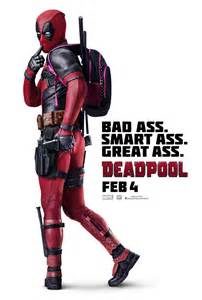 A fun movie, as promised, and also an extremely fresh and inventive one that mixes wise-ass humor and bone-crunching brutality in a manner that (nowadays at least) is quite unique. The problem is that it kinda runs out of steam after the opening twenty minutes, given that the opening credits sequence, consisting of an assortment of goofy fake credits (“Some Douchebag’s Movie,” “Produced by Some Asshats,” “Directed by An Overpaid Tool,” etc) and the stunningly over-the-top car chase/shoot-out that follows are hard to top. Still, the whole thing is undeniably enjoyable, with Ryan Reynolds as a punk who gets killed and brought back to life as the titular superhero, wearing a read jumpsuit and wielding samurai swords while attempting to make things right with his lover Morena Baccarin—who more than justifies her billing in the aforementioned goofy credits sequence as “A Hot Chick.”
A fun movie, as promised, and also an extremely fresh and inventive one that mixes wise-ass humor and bone-crunching brutality in a manner that (nowadays at least) is quite unique. The problem is that it kinda runs out of steam after the opening twenty minutes, given that the opening credits sequence, consisting of an assortment of goofy fake credits (“Some Douchebag’s Movie,” “Produced by Some Asshats,” “Directed by An Overpaid Tool,” etc) and the stunningly over-the-top car chase/shoot-out that follows are hard to top. Still, the whole thing is undeniably enjoyable, with Ryan Reynolds as a punk who gets killed and brought back to life as the titular superhero, wearing a read jumpsuit and wielding samurai swords while attempting to make things right with his lover Morena Baccarin—who more than justifies her billing in the aforementioned goofy credits sequence as “A Hot Chick.”
7. SILENCE
Easily the most uncompromising and least commercial film Martin Scorsese has ever made. Indeed, SILENCE makes THE LAST TEMPTATION OF CHRIST and KUNDUN seem downright Spielbergian in comparison, being relentlessly deliberate and austere in its approach to subject matter—Spanish missionaries in 17th Century Japan—that isn’t what you’d call titillating, contained in a severely protracted 161 minute running time. Yet for those willing to stick it out there are many rewards, from the gorgeous cinematography by Rodrigo Prieto to the deeply moving narrative arc, which pivots on the sacrifices made by two Catholic priests (Andrew Garfield and Adam Driver) tasked with spreading the gospel in the land of the rising sun, where Christians were actively persecuted. This leads to some disturbing scenes of torture and violence, scenes that will further turn off potential viewers. Yet the performances are uniformly strong, with a cast that includes the great Shinya Tsukamoto in a key supporting role.
8. DON’T BREATHE
A most welcome surprise from director Fede Alvarez (of 2013’s EVIL DEAD remake): a superbly brisk and inventive home invasion thriller. DON’T BREATHE is also quite daring in making its “heroes” a trio of youthful housebreakers. A most puzzling flaw is the fact that a pivotal early scene in which the heroine (Jane Levy) attempts to justify her amoral actions, which is paid off in a climactic sequence involving a much less savory character making a similar claim, exists only as one of the deleted scenes in the DVD. Otherwise the film is quite strong, keeping us constantly on edge as the aforementioned housebreakers break into a creepy abode owned by a blind man hoarding a vast fortune. I’ll refrain from revealing what-all happens, as the film’s main pleasure is in its sheer unpredictability.
9. 10 CLOVERFIELD LANE
This movie does so many things right it’s downright maddening when it eventually turns to shit. Expertly directed by Dan Trachtenberg, it’s a consistently absorbing account of a pretty young woman (Mary Elizabeth Winstead) abducted by a seemingly crazy man (John Goodman, reminding us that he’s one of Hollywood’s most formidable screen presences) who claims an apocalyptic event has just occurred and so encloses the two of them in an immaculately designed and maintained underground bunker, together with another abductee (John Gallagher Jr). The script, co-written by LA LA LAND’S Damien Chazelle, is ingenious in the way it constantly keeps us wondering whether Goodman is merely a paranoid nut or if some awful event has indeed befouled the world. It’s just too bad about the final 15 minutes, in which this cannily constructed, intelligent and suspenseful account devolves into a generic grade-B action/horror fest. The blame, I feel, lies with co-producers J.J. Abrams and Matt Reeves, who were evidently determined to maintain continuity with the alien invasion themed CLOVERFIELD, which they jointly made in ‘08—even though, as Abrams and Reeves have repeatedly maintained, 10 CLOVERFIELD LANE is “not a sequel.”
10. IVY (SARMASIK) 
I don’t agree with all the choices writer-director Tolga Karacelik makes herein, but did enjoy this Turkish freak-out, and appreciated its thoroughly idiosyncratic arc. It involves six men trapped on an Egypt-bound tanker after its owner goes bankrupt, resulting in bitterness, hunger and eventually madness. It’s a skilled and suspenseful piece of work, impeccably acted and photographed. My issue is with the final twenty minutes, in which the proceedings take a most unexpected dive into outright surrealism—I’ll refrain from detailing precisely what happens outside a general observation that things get VERY weird—which doesn’t jibe with the film’s otherwise staunchly realistic vibe.
11. HIDDEN FIGURES
This is a surprisingly enjoyable film given that its subject matter—the mathematical calculations involved in space travel—isn’t what I’d call inherently cinematic. Yet director Theodore Melfi (of 2014’s ST. VINCENT) has turned out an absorbing fact-based drama that focuses on the heretofore unpublicized fact that one of NASA’s most pivotal mathematicians was a black woman. Taraji P. Henson plays that woman, one Katherine G. Johnson, who if this movie is to be believed had to endure all manner of racism in NASA’s supposedly enlightened halls yet still managed to successfully calculate the trajectories of the first space missions. Her pals, played by Octavia Spencer and Janelle Monae, assist in the effort, in a film that will hopefully shut down those annoying “Whitey on the Moon” types (i.e. people who denigrate the space race because of its lack of non-white participants) once and for all!
12. MANCHESTER BY THE SEA
This, the third feature by writer-director Kenneth Lonergan, follows the obnoxiously self-indulgent MARGARET, and is unfortunately closer in feel to that film than to Lonergan’s first, the far more impressive YOU CAN COUNT ON ME. MANCHESTER BY THE SEA at least has a tremendously moving lead performance by Casey Affleck, who plays a Boston punk put in charge of looking after his teenage nephew (Lucas Hedges) despite the fact that, among other things, Affleck accidentally killed his own children in a house fire. To his credit, Lonergan avoids Hollywood bullcrap in detailing the burgeoning relationship between Affleck and his nephew, which feels very real. Less enchanting is the inflated 137 minute running time and inconsistent tone, with frank stoicism juxtaposed, uneasily, with weepy melodrama.
13. MOONLIGHT
The critical orgasming over this movie is a bit overwrought, but MOONLIGHT is impressive in its way. It may well be the first movie ever made to examine the issue of gay identity in the hood, in the form of a tortured outsider whose life we see depicted as a child, teenager and young man. Each portion is headlined by a different actor, all of whom are quite strong, while director Barry Jenkins creates a visually evocative film that finds real poetry in urban grit. The whole thing is admirably uncompromising, depicting the brutality and intimidation that are part and parcel of this character’s life, which culminates in a couple of genuinely shocking scenes. The problem is the film, despite all its virtues, lacks a satisfying resolution, with a final act that winds down rather than ends.
14. ELLE
Director Paul Verhoeven’s first feature in a decade, a French language thriller, is his most mature film to date. That’s not a recommendation, alas, as I prefer my Verhoeven movies immature. ELLE often plays like a refined variant on Verhoeven’s more characteristic BASIC INSTINCT, with Isabelle Huppert as a Parisian businesswoman who gets tangled up in a complex cat-and-mouse relationship with a masked rapist. The proceedings, in contrast to the heavily stylized surfaces of Verhoeven’s previous films, are resolutely naturalistic in look and tone, and the copious sex and nudity is done with notable restraint (especially from a director who is reputed to have broken down BASIC INSTINCT’S script with the query “How can we get more tits and cunts into this movie?”). And Huppert’s performance is flawless, keeping the film afloat even at its most uneventful (which, given the expansive 130 minute run time, it frequently is). It works, at least, presenting an appropriately disquieting depiction of rape and its aftermath whose thrills are of the intellectual rather than sensationalistic variety.
15. THE HANDMAIDEN (AH-GA-SSI)
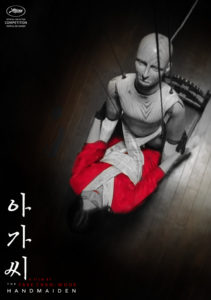 The latest film by South Korea’s Chanwook Park, who provides a typically quirky and grotesque period piece set in early 1900s Korea. Adapted from the novel FINGERSMITH by Sarah Walters, it has a young woman (Kim Tae-ri) going to work as a maid in the lavish household of a Japanese heiress (Kim Min-hee) as part of an elaborate scam engineered by a slimy crime lord (Ha Jung-woo); things are complicated considerably when the two ladies start up a lesbian relationship and begin plotting against the crime lord. Such intricate plotting, set within an extremely dense, flashback-laden structure, is a mighty tall order for Park, who’s not exactly renowned for his storytelling prowess. This makes for an oft-confusing and at times incoherent film that narratively speaking never fully satisfies. It’s a good thing the type of visual invention for which Park has become renowned is on full display in the sumptuous production design and many impossible-to-forget images (a levitating sex doll being the most striking). Park also comes through in the carnal department, providing some downright mind-blowing lesbian erotica and, in the torture-heavy final scenes, a wealth of authentically shocking nastiness.
The latest film by South Korea’s Chanwook Park, who provides a typically quirky and grotesque period piece set in early 1900s Korea. Adapted from the novel FINGERSMITH by Sarah Walters, it has a young woman (Kim Tae-ri) going to work as a maid in the lavish household of a Japanese heiress (Kim Min-hee) as part of an elaborate scam engineered by a slimy crime lord (Ha Jung-woo); things are complicated considerably when the two ladies start up a lesbian relationship and begin plotting against the crime lord. Such intricate plotting, set within an extremely dense, flashback-laden structure, is a mighty tall order for Park, who’s not exactly renowned for his storytelling prowess. This makes for an oft-confusing and at times incoherent film that narratively speaking never fully satisfies. It’s a good thing the type of visual invention for which Park has become renowned is on full display in the sumptuous production design and many impossible-to-forget images (a levitating sex doll being the most striking). Park also comes through in the carnal department, providing some downright mind-blowing lesbian erotica and, in the torture-heavy final scenes, a wealth of authentically shocking nastiness.
16. DER BUNKER
To think: I was convinced EVOLUTION represented the freakiest 2016 had to offer. The German made DER BUNKER is easily its equal in terms of twisted strangeness, although it isn’t nearly as strong. Stylized to the point of absurdity (which appears to have been the intent), it features a naïve college student (Pit Bukowski) unwisely electing to reside in the underground bunker-home of a twisted couple and their “young son” Klaus (Daniel Fripan)—who’s actually a grown man who claims to be eight years old. The student is unwillingly made to become Klaus’s teacher, and witnesses the wildly inappropriate methods his parents use to discipline him, as well as the fact that Klaus’s mother (Oona von Maydell) has a disembodied voice that speaks to her through an open leg wound. The student also learns that his own role in this evolving psychodrama is more intimate than he could possibly have anticipated. Precisely what director Nikias Chryssos had in mind here, outside a lot of scattershot weirdness-for-weirdness’ sake, is anyone’s guess. DER BUNKER is at least compelling in its way, with a style and worldview that are entirely unique.
17. BEAUTY AND THE BEAST (LA BELLE ET LA BETE)
Surprisingly, this umpteenth film version of BEAUTY AND THE BEAST turned out to be fairly strong. Directed by BROTHERHOOD OF THE WOLF’S Christophe Gans, it’s a visually rapturous take on the age-old fairy tale about a young beauty (Lea Seydoux) and her dangerous romance with a mysterious fur-covered individual (Vincent Cassel). The film’s fantasy atmosphere is as gorgeously mounted and multi-faceted as any I’ve seen (it’s everything Ridley Scott was trying for in the overdone LEGEND), and Lea Seydoux fits into this enchanted landscape surprisingly well. Unfortunately Gans goes overboard with the CGI in the final scenes; slithering tentacle effects are fine, but Gans doesn’t seem to know when to stop. That’s a problem, of course, that overwhelmed his previous film SILENT HILL, although this one has enough visual splendor to at least warrant a recommendation.
18. DESIERTO
This Spanish language flick, directed by Jonas Cuaron—the son of Alfonso Cuaron, who co-produced—has been roundly criticized for trivializing the plight of Mexican 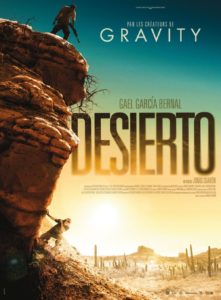 immigrants. Yet taken purely as THE MOST DANGEROUS GAME-styled exploitation it works fairly well, with a relentlessness that favorably recalls 1970s desert-set horror fests like SAVAGES and THE HILLS HAVE EYES. As they proved with GRAVITY (which Jonas co-scripted), the Cuarons favor minimalism, which is evident in this no-frills account of illegal immigrants traversing the unforgiving desert bordering Texas, where a psychotic rifle wielding gringo (Jeffrey Dean Morgan, Hollywood’s current go-to bad guy) hunts them. That’s about all there is to this film from a narrative standpoint, but it’s enhanced by the oft-gory action, cleverly modulated suspense and impressively textured visuals, which present the harsh desert landscapes in a magisterial manner similar to GRAVITY’S depiction of outer space. The ultra-wobbly handheld camerawork, however, is a constant annoyance!
immigrants. Yet taken purely as THE MOST DANGEROUS GAME-styled exploitation it works fairly well, with a relentlessness that favorably recalls 1970s desert-set horror fests like SAVAGES and THE HILLS HAVE EYES. As they proved with GRAVITY (which Jonas co-scripted), the Cuarons favor minimalism, which is evident in this no-frills account of illegal immigrants traversing the unforgiving desert bordering Texas, where a psychotic rifle wielding gringo (Jeffrey Dean Morgan, Hollywood’s current go-to bad guy) hunts them. That’s about all there is to this film from a narrative standpoint, but it’s enhanced by the oft-gory action, cleverly modulated suspense and impressively textured visuals, which present the harsh desert landscapes in a magisterial manner similar to GRAVITY’S depiction of outer space. The ultra-wobbly handheld camerawork, however, is a constant annoyance!
19. DE PALMA
A documentary on filmmaker Brian De Palma, directed by Noah Baumbach and Jake Paltrow, that’s notably minimalistic. This is to say that it consists solely of the seventyish De Palma talking about his films, and nothing else. His musings are interspaced with the requisite clips from those films, as well as those of other filmmakers (including VERTIGO and PSYCHO) and some home movie footage shot by De Palma’s longtime chum Steven Spielberg. De Palma proves to be an engaging speaker who’s admirably frank about his topsy-turvy odyssey through Hollywood, and also his many failures. Revelations include claims that Cliff Robertson was a giant pain in the ass on the set of OBSESSION, that RAISING CAIN was supposed to be structured entirely differently than it turned out, and that De Palma personally moved an Iraqi actress who appeared in REDACTED to France and paid for her schooling. Good flick, but I really wish there was more to it.
20. THE PURGE: ELECTION YEAR
It’s a fact that the PURGE franchise improves with each succeeding film, meaning this third and latest PURGE flick is easily the best of the three. It’s set, appropriately enough, in an election year, and centers on a woman senator (Elizabeth Mitchell) running for president who wants to end the annual purge. This, as anyone familiar with the previous films well knows, refers to one night out of each year in which all crime is legal; Ms. Mitchell ends up thrust into the streets of Washington, D.C. during the latest Purge night, with Sergeant Barnes, a returnee from the last PURGE, on hand to look after her. As in the previous installments, writer-director James DeMonaco includes a lot of political sloganeering that grows heavy-handed at times. DeMonaco also stages a lot a lot of elaborate action sequences, which only point up the fact that action filmmaking is NOT his specialty! Still, the film is quite entertaining, with plucky protagonists played by strong actors (Frank Grillo as Barnes and FORREST GUMP’S Mykelti Williamson being foremost among them) who it’s impossible not to root for, as well as quite a few twisted surprises (my favorite being the unforgettable “Candy Girls” sequence).
21. PASSENGERS
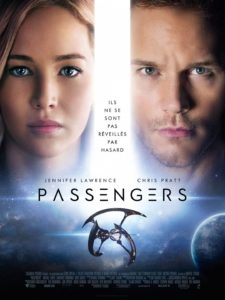 A sci fi popcorn flick that’s not nearly as terrible as the critics have made it out to be. The first half is actually pretty good, with Chris Pratt (not exactly my first choice as an introspective sci fi hero but surprisingly engaging here) as a narcotized inhabitant of a space station who one day is woken up, even though the station has another ninety-plus years to go before reaching its destination. Quickly growing bored with his situation, Pratt wakes up a fellow passenger, a hot chick played by Jennifer Lawrence. This leads to the expected romantic business, but the moral implications of Pratt’s actions still have to be reckoned with, as does the reason he was woken up in the first place. All this is compelling enough, but the film loses its footing around the point when a third character (Lawrence Fishburn) appears, and the proceedings turn into TITANIC IN SPACE, with a lot of excess CGI and an increasingly implausible succession of catastrophes.
A sci fi popcorn flick that’s not nearly as terrible as the critics have made it out to be. The first half is actually pretty good, with Chris Pratt (not exactly my first choice as an introspective sci fi hero but surprisingly engaging here) as a narcotized inhabitant of a space station who one day is woken up, even though the station has another ninety-plus years to go before reaching its destination. Quickly growing bored with his situation, Pratt wakes up a fellow passenger, a hot chick played by Jennifer Lawrence. This leads to the expected romantic business, but the moral implications of Pratt’s actions still have to be reckoned with, as does the reason he was woken up in the first place. All this is compelling enough, but the film loses its footing around the point when a third character (Lawrence Fishburn) appears, and the proceedings turn into TITANIC IN SPACE, with a lot of excess CGI and an increasingly implausible succession of catastrophes.
22. SULLY
A prestige movie biopic of Captain “Sully” Sullenburger, who in 2009 famously landed an airliner in the Hudson River after both engines went out. Clint Eastwood was the director and Tom Hanks the star, and they nearly come up with a worthwhile movie in spite of the fact that the relentlessly taciturn Sully is not an especially warm or inviting protagonist—and that the script contains an abundance of Hollyweird BS. That latter aspect includes a lengthy tribunal to which Sully is subjected by the airline honchos, who question whether he did the right thing by landing in the Hudson. Of course Sully has all the correct answers, and manages to shut down his doubters in the expected stand-up-and-cheer resolution; how close to reality this is I have no idea, but it plays very Hollywood-like. More affecting is the recreation of the plane landing and all the confusion and apprehension that accompanied it, as well as the performance of Hanks, who captures Sully’s taciturn demeanor quite well.
23. THE SHALLOWS
An enjoyable enough bit of minimalistic fluff, with Blake Lively as a surfer babe in Mexico looking to sample the waves of a secluded cove. Anyone who knows anything 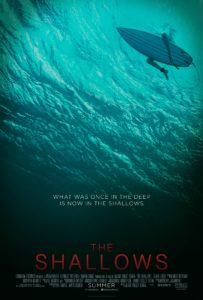 about surf culture will already be concerned about her safety (as localism is a very real, and deadly, factor in the surf sphere), and indeed things get quite hairy when Lively blunders into the feeding path of a large shark that effectively strands her on an ocean rock. Director Jaume Collet-Serra does a fairly good job building and sustaining suspense amid what were reportedly extremely difficult shooting conditions, and Lively makes for quite an arresting centerpiece; even freezing on a rock she manages to look damned alluring. The film doesn’t ultimately go anywhere particularly interesting or unexpected, and over-relies on CGI effects to make its points, but does its job nonetheless.
about surf culture will already be concerned about her safety (as localism is a very real, and deadly, factor in the surf sphere), and indeed things get quite hairy when Lively blunders into the feeding path of a large shark that effectively strands her on an ocean rock. Director Jaume Collet-Serra does a fairly good job building and sustaining suspense amid what were reportedly extremely difficult shooting conditions, and Lively makes for quite an arresting centerpiece; even freezing on a rock she manages to look damned alluring. The film doesn’t ultimately go anywhere particularly interesting or unexpected, and over-relies on CGI effects to make its points, but does its job nonetheless.
24. HELL OR HIGH WATER
A notably eccentric attempt at a Southern-fried heist movie by Scottish director David Mackenzie, who makes what is very much a “tourist movie.” This is to say that Mackenzie spends a lot of time exploring the colorful byways of the American landscape, often at the expense of narrative clarity. That narrative concerns two brothers (Ben Foster and Chris Pine) who in a bid to save their late father’s ranch stage a series of hold-ups that inevitably turn deadly. Jeff Bridges, displaying all his standard mannerisms, plays the Texas Ranger on the brothers’ trail. It’s all very quirky, with supporting characters who often upstage the main players, as well as some mighty striking cameo appearances (a tarty waitress being the most memorable). The action sequences aren’t bad, either. As for the film overall, it nearly succeeds, though not quite, being essentially a collection of impressively composed portions in search of a unified whole.
Recommended DVD Releases
As one of the three or so people left who still buy DVDs and blu-rays, I feel duty-bound to continue recommending worthwhile digital releases in my year end round-ups. A major problem facing DVD collectors and distributors, I realize, is that there are so few worthwhile films left to release–which explains why 2016’s DVD premieres included the likes of C.H.U.D. II: BUD THE CHUD and CHOPPING MALL. Still, there were several worthwhile, and even essential, DVD releases in ’16—most of them, unsurprisingly, from the Criterion Collection—starting with…
BELLADONNA OF SADNESS
It’s taken over forty years, but this psychedelic animated wonder from Japan is finally available in NTSC blu ray format. An absolute must!
CAT PEOPLE
A Criterion-ized release of Val Lewton’s CAT PEOPLE! I’ve long held that this film is overrated, but it’s damn good nonetheless.
CHIMES AT MIDNIGHT
It’s taken even longer than it did for BELLADONNA OF SADNESS, but this long lost 1965 Orson Welles directed (with assistance from Jess Franco) epic is here at last from, once again, Criterion.
THE COMPLETE LADY SNOWBLOOD
Yes, the Japanese LADY SNOWBLOOD films were already available on DVD in the US, but this new Criterion release makes for a welcome upgrade.
DEKALOG
Yet another must-have Criterion package, this time of Krzysztof Kieslowski’s masterful 10-part drama that has been (falsely) reputed to be patterned on the 10 Commandments.
FANTASTIC PLANET
Still more goodness from Criterion, who here work their magic on Rene Laloux and Roland Topor’s animated sci fi masterpiece.
J’ACCUSE!
Abel Gance’s 1938 anti-war drama (a remake of Gance’s similarly titled 1919 film, which is already available on DVD) contains an overwhelming zombie march finale that prefigured NIGHT OF THE LIVING DEAD by three decades.
JOHNNY GUITAR
I’ve always gotten a kick out of this bizarre existential western, directed by Nicholas Ray and scripted by (or at least credited to) Philip Yordan.
LUNA
Bernardo Bertolucci’s controversial incest drama is legally available at last—although I’ve heard some less-than-encouraging things about the sound quality on this release!
SONNY BOY
Arguably the most important DVD release on 2016, presenting the first-ever digitized version of one of the weirdest, most subversive movies of all time. And with that out of the way it’s now, I’m sorry to report, time for…
The Worst:h1. HAIL, CEASAR!
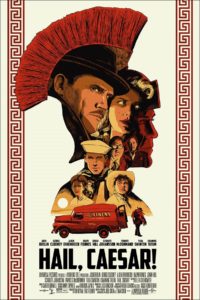 A serious candidate for worst Coen brothers movie ever, a painfully unfunny, disjointed and self-satisfied comedy set in 1940s-era Hollywood. There a biblical epic is being made by a tough studio mogul (Josh Brolin) who registers as one of those Coen protagonists (like those of THE MAN WHO WASN’T THERE and INSIDE LLEWYN DAVIS) the bros evidently find endlessly fascinating, but they never succeed in communicating that fascination to the viewer. An assortment of sharp supporting players (Tilda Swinton as twin Helda Hoper-esque columnists, Scarlett Johansson as an Esther Williams-esque starlet, Veronica Osorio as a Carmen Miranda-esque singer) turn up, each with an intriguing backstory, but none of those stories are ever paid off. Rather, the film keeps shifting its focus back to Brolin, who would have been better off as one of those supporting players—preferably one with limited screen time!
A serious candidate for worst Coen brothers movie ever, a painfully unfunny, disjointed and self-satisfied comedy set in 1940s-era Hollywood. There a biblical epic is being made by a tough studio mogul (Josh Brolin) who registers as one of those Coen protagonists (like those of THE MAN WHO WASN’T THERE and INSIDE LLEWYN DAVIS) the bros evidently find endlessly fascinating, but they never succeed in communicating that fascination to the viewer. An assortment of sharp supporting players (Tilda Swinton as twin Helda Hoper-esque columnists, Scarlett Johansson as an Esther Williams-esque starlet, Veronica Osorio as a Carmen Miranda-esque singer) turn up, each with an intriguing backstory, but none of those stories are ever paid off. Rather, the film keeps shifting its focus back to Brolin, who would have been better off as one of those supporting players—preferably one with limited screen time!
2. THE FOREST
Yet another case of promising subject matter given lackluster execution. The subject here is Aokigahara, Japan’s so-called “Suicide Forest” wherein around 100 people are alleged to off themselves each year. This would seem ideal material for a horror movie, but THE FOREST deals with the subject in shockingly bland and uninteresting fashion. The protagonist is a young American woman, played by Natalie Dormer, who searches Aokigahara for her missing twin sister. Director Jason Zada builds up a great deal of anticipation, making us wait a half hour for the heroine to enter the forest; the problem is that nothing very interesting happens once she does, with the surreal and atmospheric horror fest the film seemed to have been building toward jettisoned in favor of a mess of uninspired clichés.
3. MEKONG HOTEL
A pretty insufferable bit of arthouse pud-pulling from Thailand’s gifted Apichatpong Weerasethakul. A companion-piece of sorts to Weerasethakul’s Cannes winning triumph 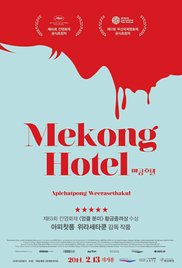 UNCLE BOONMEE WHO CAN REMEMBER HIS PAST LIVES, the digitally shot MEKONG HOTEL consists of a filmmaker discussing the narrative of a horror movie with its lead actress in a beachfront hotel, while a cannibalistic vampire woman goes about her gruesome business. Weerasethakul appears to have been trying for an effect similar to that of Pere Portabella’s brilliant docu-ficton montage CUADECUC, VAMPIR (1970), but never comes close to achieving it. Ultimately MEKONG HOTEL comes off as exactly what it is: a brief collection of scenes slapped together with no evident rhyme or reason, with lengthy shots of the scenery surrounding the hotel to further pad its 57 minutes out.
UNCLE BOONMEE WHO CAN REMEMBER HIS PAST LIVES, the digitally shot MEKONG HOTEL consists of a filmmaker discussing the narrative of a horror movie with its lead actress in a beachfront hotel, while a cannibalistic vampire woman goes about her gruesome business. Weerasethakul appears to have been trying for an effect similar to that of Pere Portabella’s brilliant docu-ficton montage CUADECUC, VAMPIR (1970), but never comes close to achieving it. Ultimately MEKONG HOTEL comes off as exactly what it is: a brief collection of scenes slapped together with no evident rhyme or reason, with lengthy shots of the scenery surrounding the hotel to further pad its 57 minutes out.
4. PRIDE AND PREJUDICE AND ZOMBIES
I never got into the literary mash-up craze of the 00’s, which happens to have been kicked off by the book that inspired this movie, so it shouldn’t surprise anyone that said movie left me cold. Much like the book, the flick never succeeds in gelling its twin polarities—Jane Austen romantic drama and zombie gorefest—not least because the narrative fails to satisfy in either department. To be more specific, the 19th Century period detail is about on the level of a substandard Masterpiece Theater broadcast, and the zombie business plays like twelfth-tier George Romero. It’s a fact that zombie-killing babes like this film’s revamped Jane Austen heroine (Lily James) are a dime a dozen these days, as are Merry-auld-Englund dramas, leaving us with a film that doesn’t work in either category, nor as a unified whole.
5. THE GIRL ON THE TRAIN
Or: GONE GIRL lite. Like that 2014 film, this one was adapted from a bestselling woman-centric novel, stars a high profile British actress (Emily Blunt), and features a narrative that pivots on a marriage gone horrifically wrong. Blunt plays an alcoholic woman who likes to look out a train window each morning, which causes her to become involved in the lives of a couple who live in a house Blunt previously inhabited with her ex-husband (Justin Theroux); then a murder occurs that throws everything up in the air. For roughly its first half the film appears to be shaping up as a complex and sophisticated thriller, but it goes downhill fast, and falls apart entirely in a ridiculous denouement that cheats (asking us to believe that the recovered memories so important to the unfolding narrative are in fact false). Blunt at least gives her all in an at-times powerful performance, but it’s not nearly enough.
6. BATMAN VS. SUPERMAN: DAWN OF JUSTICE
I think by now we can all face up to the truth about this movie. This is to say that critics and audiences were not wrong in finding fault with BATMAN VS. SUPERMAN, and that their criticisms were not motivated by anti-DC Comics sentiment. As a horror fiend I can’t argue with director Zack Snyder’s ultra-dark take on DC’s most iconic heroes, but the relentlessly glum, humorless atmosphere grew quite annoying after a while. Matters aren’t helped by the fact that, with the introduction of Wonder Woman (Gal Gadot) in addition to Batman (Ben Affleck), Superman (Henry Cavill), Lex Luthor (Jesse Eisenberg), Lois Lane (Amy Adams) and Ma Kent (Diane Lane), there are far too many characters for Snyder to properly keep track of (a common problem in modern superhero movies). Further damage is done by a narrative that outside the titular Batman-Superman rivalry is generic and uninvolving. For that matter, the rivalry in question is basically a wash, with the much-heralded Batman-Superman mano-a-mano brought about by outside forces, and over with far too soon. Equally underwhelming is the ending, which reminded me of nothing so much as the concluding scenes of STAR TREK II: THE WRATH OF KHAN — in which, you may recall, a pivotal character is killed off (complete with a lot of excess crying and laments), but not really…
7. A MONSTER CALLS
I’m on record as having disliked the children’s book A MONSTER CALLS by Patrick Ness, and I liked this British made film adaptation even less. As in the book, it features a sullen young boy (Lewis MacDougall) trying to cope with the terminal cancer suffered by his mother (Felicity Jones). Luckily, a Liam Neeson-voiced tree monster shows up to help the kid deal with his emotions by relating three stories germane to his situation. The presentation of those stories, via heavily stylized animation, constitutes the film’s most interesting element. Less enchanting is the copious CGI, which is utilized in a ham-fisted and strikingly unimaginative manner by director J.A. Bayona, and the script’s attempts at tying the monster’s stories into Jones’ imagination (something that wasn’t in the book), done in a tacked-on epilogue that has the effect of blunting the emotional impact of what should have been the final scene.
8. COSMOS
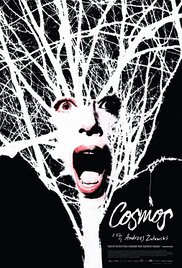 Andrzej Zulawski’s final film, unfortunately, was this deadening concoction about an unstable young man attempting, uneasily, to subside in his family’s rural estate. Promising material to be sure, and it’s done up in Zulawski’s patented over-the-top manner, marked by a highly exaggerated reality and hysterical performances. Unfortunately, as is the case with most of Zulawski’s films, pretty much everyone in this hothouse atmosphere is completely bugfuck, so the protagonist’s breakdown doesn’t seem like much of a big deal. Nor does the movie overall, which follows a predictable course—several animals are killed, leading up to the inevitable murder of a human—and is punishingly dull.
Andrzej Zulawski’s final film, unfortunately, was this deadening concoction about an unstable young man attempting, uneasily, to subside in his family’s rural estate. Promising material to be sure, and it’s done up in Zulawski’s patented over-the-top manner, marked by a highly exaggerated reality and hysterical performances. Unfortunately, as is the case with most of Zulawski’s films, pretty much everyone in this hothouse atmosphere is completely bugfuck, so the protagonist’s breakdown doesn’t seem like much of a big deal. Nor does the movie overall, which follows a predictable course—several animals are killed, leading up to the inevitable murder of a human—and is punishingly dull.
9. BATMAN: THE KILLING JOKE
I guess we shouldn’t be surprised that in turning one of the most celebrated comics of all time, the Alan More scripted THE KILLING JOKE, into an animated feature some colossal mistakes were made. Most of those mistakes occur in the opening thirty minutes, which focus on Barbara Gordon, a.k.a. Batgirl, portrayed here as a whiney brat whose main object is apparently to seduce Batman. After that we get a faithful rendition of the comic, in which Barb is shot and paralyzed by the Joker, who aims to drive Commissioner Gordon (Barbara’s father) insane in an abandoned amusement park. The noirish fatalism of Moore’s tale doesn’t sit too well with the sloppily conceived prologue, which is standard comic book BS. Another problem is with the animation, which is very much of the old school hand drawn style, and shockingly slapdash (evident in the staticy backgrounds with their non-moving figures)—thus, said animation is very much in keeping with the scripting of the early scenes, so at least the filmmakers were consistent in one respect.
10. THE NEON DEMON
It’s always a shame when a talented filmmaker turns self-indulgent, and that’s precisely what happened to Nicolas Winding Refn, who following his Cannes-awarded triumph DRIVE has taken to putting out a documentary about himself (2014’s MY LIFE DIRECTED BY NICOLAS WINDING REFN) and plastering his initials all over the beginning and end credits of this, his latest and most pretentious film. It’s an art-horror fest about the perils of the modeling industry, as experienced by a naive young woman (Elle Fanning) who is quite literally devoured by this alluring but fatally artificial and manufactured world. There are some affecting elements here and there, but they’re drowned out by all the silly and affected ones, with striking but wildly overdone color-coded visuals that aren’t helped by the semi-coherent narrative that switches character viewpoints at whim, nor the positively skin-crawling techno score. I will, however, give kudos to the cast: Fanning is terrific in the lead role, adroitly navigating her character’s initial naiveté and resultant narcissistic psychosis, but the real revelation for me was Jena Malone as a predatory lesbian agent. I’ve never thought of Malone as a sexpot, but here she turns in what is likely the most uninhibited performance by any actress in recent memory, with an erotic scene with a female corpse(!) that’s a guaranteed jaw dropper.
11. THE LOBSTER
Yet another case of high hopes dashed. THE LOBSTER was the English language debut of DOGTOOTH’s brilliant Yorgos Lanthimos, who attempts a wholly bizarre science 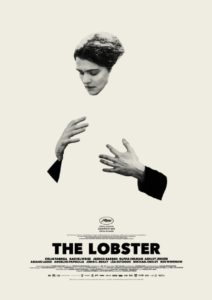 fiction romance with only partial success. Colin Farrell stars as one of several single folk who are taken to a secluded hotel where they’re tasked with finding a romantic partner; the penalty for not doing so is that they get turned into animals of their choosing, in Farrell’s case a lobster. The first 45 minutes or so, involving Farrell’s participation in a hunt whose prey is human and his early attempts at finding a mate—which end in him taking his prospective partner to the “transformation” room—are rich and fascinating in the best Lanthimos tradition. After that, however, Farrell meets his apparent true love in the form of Rachel Weisz, and the film loses its hold. It’s hard to say exactly why, but the uniformly staid and detached filmmaking grows annoying, as does the deadpan acting. Too bad.
fiction romance with only partial success. Colin Farrell stars as one of several single folk who are taken to a secluded hotel where they’re tasked with finding a romantic partner; the penalty for not doing so is that they get turned into animals of their choosing, in Farrell’s case a lobster. The first 45 minutes or so, involving Farrell’s participation in a hunt whose prey is human and his early attempts at finding a mate—which end in him taking his prospective partner to the “transformation” room—are rich and fascinating in the best Lanthimos tradition. After that, however, Farrell meets his apparent true love in the form of Rachel Weisz, and the film loses its hold. It’s hard to say exactly why, but the uniformly staid and detached filmmaking grows annoying, as does the deadpan acting. Too bad.
12. EQUITY
For what it is, i.e. a glorified TV movie, EQUITY is perfectly fine. It purports to be a female-centric take on the male-dominated likes of WALL STREET, THE WOLF OF WALL STREET and THE BIG SHORT, but lacks the energy and excitement of those films, with the woman dominated cast being the only interesting element. It features BREAKING BAD’S Anna Gunn as a disgraced investment banker having to contend with betrayal and corruption on Wall Street. Ms. Gunn has a couple of electrifying moments, such as a freak-out over the amount of chocolate chips in a cookie (which far outdoes Robert DeNiro’s similar rant in CASINO), that occasionally lift this film out of its dreariness, but those moments are few and far between.
13. ARRIVAL
Everyone and their grandmother is praising this film to the skies…why, I can’t fathom! Sure, the director Denis Villeneuve is one of the most talented filmmakers on the scene, and the cast (Amy Adams, Jeremy Renner, Forest Whitaker) is first rate, but the film just never connected with me. It’s well visualized, certainly, being a lush and atmospheric account of an investigation of an extraterrestrial spacecraft carried out by Adams as a linguistic expert and Renner as a military man. Adams becomes convinced that the spacecraft’s inhabitants are friendly, but of course everyone else insists on viewing them as hostile—can she manage to convince people of the aliens’ true natures before something catastrophic occurs? The film is not unlike classic first contact flicks like THE DAY THE EARTH STOOD STILL and CLOSE ENCOUNTERS OF THE THIRD KIND, and also partakes of the dead relative motif that powers seemingly every modern sci fi movie (CONTACT, A.I., GRAVITY, INTERSTELLAR, etc). In short, it contains very little we haven’t already seen before.
14. THE EDGE OF SEVENTEEN
The publicity for this movie, the debut of writer-director Kelly Fremon Craig, evoked iconic teen flicks like FAST TIMES AT RIDGEMONT HIGH, THE BREAKFAST CLUB and JUNO—none of which are just comparisons! THE EDGE OF SEVENTEEN plays like a TV movie, and a pretty facile one, with Hailee Steinfeld as a teenaged outsider bitching and moaning about her life…which about sums up the entire narrative. One of the movie’s many problems is with the casting of Steinfeld, who is, frankly, waaay too cute to be convincing as a dork-ette—albeit one who, in the manner of so many modern movie teens, possesses an impossibly thorough grasp of pop culture minutiae and an impressive verbal dexterity. Eventually, with the help of Woody Harrelson as a gruff but loving teacher, she comes to recognize the error of her ways and becomes a better person, by which point I’d lost interest.
15. THE WITCH
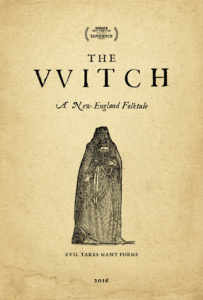 Yet another vastly acclaimed 2016 film that left me cold. Based, allegedly, on actual documents relating to witchcraft in 1600s New England, it concerns a family residing in that very place and time. Also afoot is a witch who casts a spell on the family’s young son, causing his parents to blame his sister when strangeness inevitably befalls the land. In this way writer-director Robert Eggers gets to have it both ways, showing the fear and superstition that led to so many women being falsely accused of witchcraft in the 17th Century while also delivering the expected supernatural thrills. But the film is never very thrilling, being relentlessly distant and uninvolving despite its beautifully designed and photographed veneer. Nor does the narrative ever go anywhere very interesting, offering up a twist ending that’s medium strength at best.
Yet another vastly acclaimed 2016 film that left me cold. Based, allegedly, on actual documents relating to witchcraft in 1600s New England, it concerns a family residing in that very place and time. Also afoot is a witch who casts a spell on the family’s young son, causing his parents to blame his sister when strangeness inevitably befalls the land. In this way writer-director Robert Eggers gets to have it both ways, showing the fear and superstition that led to so many women being falsely accused of witchcraft in the 17th Century while also delivering the expected supernatural thrills. But the film is never very thrilling, being relentlessly distant and uninvolving despite its beautifully designed and photographed veneer. Nor does the narrative ever go anywhere very interesting, offering up a twist ending that’s medium strength at best.
16. SNOWDEN
This is Oliver Stone’s best film in years, but it still can’t hold a candle to his earlier work. It’s a biopic of Edward Snowden, the government whistleblower who alerted America to the true extent of the surveillance being visited on us—and is now living in exile in Russia. Joseph Gordon Levitt does a reasonably good impersonation of Snowden, who turns up in the flesh in the final scenes. Shailene Woodley also appears as Snowden’s long-suffering GF, on hand to bitch that he’s not spending enough time with her but eventually learning to live with his eccentricities. The whole thing is slick and entertaining, and quite ballsy in its unabashed celebration of Snowden and his activities (with the Obama administration presented as the major antagonist), but SNOWDEN lacks the propulsive energy of Stone’s eighties and nineties-era films. In other words, it’s a film that any semi-gifted filmmaker could make, something that can’t be said of Oliver Stone entertainments from years past like PLATOON, WALL STREET, JFK and NATURAL BORN KILLERS.
17. LA LA LAND
This umpteenth attempt at repackaging the 1930s-era musical formula for a new era follows AT LONG LAST LOVE, NEW YORK NEW YORK, ONE FROM THE HEART and EVERYONE SAYS I LOVE YOU. Those films, you’ll recall, were all failures, and so (despite all the ejaculatory critical notices it’s been getting) is LA LA LAND, an especially bloated and uneven attempt at a neo-musical. The second feature by Damien Chazelle, it’s nearly identical in tone to his first, 2014’s WHIPLASH, being concerned with the true cost of following one’s dreams in a musical environ. But whereas WHIPLASH was impressively lean and focused, LA LA LAND is lengthy and plodding, focused on a love story that isn’t nearly as interesting as Chazelle seems to think it is. Essentially it’s about Ryan Gosling as a frustrated musician and Emma Stone as a frustrated actress getting together, breaking up, getting together again and breaking up again in a bevy of scenic LA locales. The two periodically break into song, which only highlights the fact that neither is much of a singer. The film is technically impressive, sure, but in its place I’d recommend viewing one of the actual old timey musicals it seeks to emulate.
18. NOCTURAL ANIMALS
Another film that thinks it’s a lot more profound than it actually is. Adapted from the 1993 novel TONY AND SUSAN by Austin Wright, this is a quasi-thriller with Amy Adams as a rich bitch reading a novel written by her ex-husband (Jake Gyllenhaal). The novel, which we see dramatized, involves a man (Gyllenhaal) harassed by scumbags who murder his wife (Isla Fisher) and daughter, leading to a bloody revenge. Adams takes the novel to be a trenchant commentary on her marriage to Gyllenhaal, which she ended to run off with a better looking stud (Armie Hammer)—her conclusion: perhaps she should have stuck around! As a thriller the film doesn’t really work, and nor is it too satisfying as a marital drama, although the interplay of fiction and reality is inspired. I can only imagine what the late Dennis Potter, the undisputed master at this sort of thing, might have done with this material.
19. DEMON
A return to the under-utilized Jewish horror movie trope pioneered by 1937’s THE DYBBUK. In this Polish oddity we have a young groom (Itay Tiran) possessed by a dybbuk (an unquiet spirit from Jewish mythology that’s said to take over a still-living person’s body) during his raucous wedding festivities, which causes him to behave mighty strangely. What makes the film intriguing is the earthy and studiedly non-horrific aura created by director Marcin Wrona, who steadfastly avoids overt “scares.” This makes for an interesting and eccentric, though unfortunately never very compelling or noteworthy, film. DEMON, alas, seems destined to be most widely remembered for the fact that Wrona committed suicide in September 2015, during a film festival in which DEMON was being screened.
20. HIGH-RISE
I’ve long believed J.G. Ballard’s 1975 novel HIGH-RISE would make a great movie. It might still make a worthwhile movie some day, but this misguided adaptation isn’t it. The intentions of director Ben Wheatley and his wife Amy Jump (who scripted and co-edited) appear to have been valiant, but something evidently went very wrong in the transposition from novel to film. As in said novel we have a futuristic British high-rise whose inhabitants—who include a randy psychologist (Tom Hiddleston), an eccentric architect (Jeremy Irons) and a seductive single mother (Sienna Miller)—find their inhibitions dissolving amid the convenience and uneventfulness of life in the high rise, leading to much lasciviousness and savagery. Gone is the novel’s tightly focused narrative, which Wheatley replaces with a rambling collection of tenuously connected vignettes and distracting stylistic quirks (scenes shot through kaleidoscopes, etc) that only serve to distance one from the material, and make it difficult to discern why it is that all these people go so crazy. That’s really a shame, as Wheatley’s staging of the mayhem is quite robust, and his eye for stomach-clenching nastiness, first showcased in 2010’s wrenching KILL LIST, remains spot-on.
21. BIRTH OF A NATION
What ultimately does this movie in? I’d say it’s a toss-up between the overly referential attitude it takes toward its subject Nat Turner, who led a bloody slave uprising in 1831 Virginia, and the many thuddingly obvious and clichéd elements employed by writer-producer-director-star Nate Parker, such as the mournful violin music that plays over a climactic massacre and the sight of a butterfly alighting on a corpse. Of course the brutal subject matter doesn’t exactly call for subtlety, and the early scenes depicting the mistreatment of Parker and his fellow slaves are strong enough to nearly overcome Parker’s heavy-handed approach. But the pic falls apart entirely in its depiction of the uprising, glossing over the more unsavory facts of the case (such as the many infants killed by Parker and his crew), and also its aftermath, in which Parker is made to assume overtly Christ-like status.
22. DOG EAT DOG
Sometimes reading a movie’s source novel before seeing it is a bad idea. That was definitely the case with the Paul Schrader directed Nicolas Cage vehicle DOG EAT DOG, a crime drama adapted from Edward Bunker’s 1997 novel of the same name. I consider Bunker’s book, about the brutal dissolution of three ex-cons who take part in a doomed kidnapping scheme, to be one of the decade’s finest crime novels, a masterfully crafted mix of pulpy excess and gritty realism that has been optioned for film numerous times. Somehow Paul Schrader ended up with the task of filming Bunker’s text, and created a flamboyant and black-humored (read: Tarantino-esque) spectacle packed with gaudy lighting and gratuitous pop culture references (with Taylor Swift being an oft-referenced touchstone). As such the film isn’t without interest, being consistently surprising in its storytelling and visual design, and boasting the type of unhinged emoting that made Cage famous (his outrageous Humphrey Bogart imitation in the climactic scenes must be seen to be disbelieved). Unfortunately all the flamboyance is allowed to overwhelm the drama, leaving us with a textbook example of stylistic overkill.
23. KAILI BLUES (LA BIAN YE CAN)
A Chinese art film I might have enjoyed more if I hadn’t already seen Shahram Mokri’s masterful FISH & CAT. Like that film, this one is a digitally lensed ramble concerned with time and fate, as depicted through a handful of extremely long takes. It begins in straightforward fashion, with a doctor searching for his long-lost nephew; in the process he enters a mountainous region where time appears to move backwards and forwards, and director Gan Bi provides a couple of very lengthy tracking shots that directly recall the aforementioned FISH & CAT. An interesting film, but also an extremely uneven one.
24. STAR TREK BEYOND
This latest STAR TREK sequel is enjoyable enough, particularly if you see it in IMAX 3D format, but it offers very little that hasn’t been done before. As in many STAR TREK narratives it features the crew of the Enterprise stuck on a distant planet after their ship is destroyed, where they regroup and a find a new travelling companion in the form of a fetching alien chick. Good special effects and slick direction by FAST & FURIOUS specialist Justin Lin make for a diverting spectacle (although the loopy rollercoaster-esque POV shots made me physically ill), but it can’t shake the pervasive been-there-done-that feel. That’s it! But before signing off I’ll leave you with some upcoming releases that are especially promising, some of which I’ve already seen and some I haven’t…
Looking Forward…
BEHEMOTH
A peerlessly haunting quasi-documentary “essay film” from China that ranks with 2012’s stunning Russian import LEVIATHAN.
BLADE RUNNER 2049
I’m actually excited—wrongly, I’m sure!—about this decades-after-the-fact BLADE RUNNER follow-up, directed by ARRIVAL’S Dennis Villeneuve.
FIRES ON THE PLAIN
The incomparable Shinya Tsukamoto helmed this hellaciously brutal 2014 remake of Kon Ichikawa’s antiwar classic, but it has yet to turn up (in any form) in the western world.
I, OLGA HEPNAROVA
A chilly docudrama about the notorious Czech murderess Olga Hepnarova, superbly incarnated by Michalina Olszanska.
KING DAVE
One of the most innovative films of 2016 was this Canadian made one take wonder about the violent and darkly comedic misadventures of a chatty punk.
THE OTHER SIDE OF THE WIND
The imdb page for this film, Orson Welles’ long-in-the-works final feature, is currently 2017, so let’s hope it finally turns up!
WE MONSTERS
A German gut-wrencher that plays like a more audience-friendly variant on the infamous Michael Haneke downer BENNY’S VIDEO, with parents covering up a murder committed by their daughter—an act that leads to all sorts of unforeseen complications.

